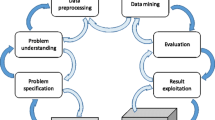Abstract
Scientific databases, and in particular chemical and biological databases, have reached massive sizes in recent years due to the improvement of bench-side high throughput screening tools used by scientists. This rapid increase has caused a shift in the bottleneck in discovery and product development from the bench side to the computational side, thus, creating a need for new computational tools that can facilitate the access and interpretation of such massive data.
This paper discusses the design and implementation of the computation of a histogram to speed up access to large pharmaceutical databases. As opposed to traditional histograms in which approximate value distributions is obtained by grouping attribute values into buckets, the computation histogram proposed in this paper records the retrieval time and the calculation time of descriptors in a pharmaceutical drug candidate database. Both on-line and off-line update techniques are proposed to update the computation histogram so that an efficient query plan can be generated.
The efficiency of the proposed computation histogram is demonstrated by using a drug candidate database which is used in the pharmaceutical drug discovery process. The histogram allows the result of a query to be either computed using a computational algorithm or retrieved from the database. In addition to the pharmaceutical drug candidate database, the proposed approach is applicable to other scientific databases such as biological and agroscience databases.
Similar content being viewed by others
References
Aboulnaga, A. and Chaudhuri, S. (1999). Self-Tuning Histograms: Building HistogramsWithout Looking at Data. In Proceedings of the ACM SIGMOD Conference.
Baru, C.K., et al. (1995). DB2 Parallel Edition. IBM Systems Journal, 34(2), 292–322.
Ben Miled, Z., Zaitsev, A., Bukhres, O., Bem, M., Jones, R., and Opplet, R. (2000a). Efficient Data Representation in Very Large Datebases: A Case Study of a Pharmaceutical Data Repository. In International Conference on Computers and their Applications.
Ben Miled, Z., Liu, Y., Powers, D., Bukhres, O., Bem, M., Jones, R., Opplet, R., and Milosevich, S. (2000b). Data Access Performance in a Large and Dynamic Pharmaceutical Drug Candidate Database. IEEE Supercomputing.
Chen, C.M. and Roussopoulos, N. (1994). Adaptive Selectivity Estimation Using Query Feedback. In Proceedings of the ACM SIGMOD Conference (pp. 161–172).
Daylight Chemical Information Systems, Inc. SMILES Tutorial. Available at http://www.daylight.com/ dayhtml/smiles/smiles-intro.html.
Elmasri, R. and Navathe, S.B. (2000). Fundamentals of Database System. McGraw Hill.
Gibbons, P.B. and Matias, Y. (1998). New Sampling-Based Summary Statistics for Improving Approximate Query Answers. In Proceedings of the ACM SIGMOD Conference.
Hallmark, G. (1997). Oracle ParallelWarehouse Server. IEEE Transactions on Knowledge and Data Engineering, 314–320.
Informix. Informix Extended Parallel Server 8.3. Available at http://www.informix.com/xps/.
Ioannidis, Y. and Poosala, V. (1995). Balancing Histogram Optimality and Practicality for Query Result Size Estimation. In Proceedings of the ACM SIGMOD Conference (pp. 233–244).
Kabra, N. and DeWitt, D.J. (1998). Efficient Mid-Query Re-Optimization of Sub-Optimal Query Execution Plans. In Proceedings of the ACM SIGMOD Conference (pp. 106–117).
Kooi, R.P. (1980). The Optimization of Queries in Relational Databases. PhD thesis. Case Western Reserver University.
Liu, Y., Ben Miled, Z., Bukhres, O., Bem, M., Jones, R., and Oppelt, R. (2000). Efficient Schema Design for a Pharmaceutical Data Repository. In IEEE symposium on Computer Based Medical Systems.
Locke, P. (1999). Oracle Call Interface: Programmer's Guide. Oracle Corporation.
Matias, Y., Vitter, J.S., and Wang, M. (1998).Wavelet-Based Histograms for Selectivity Estimation. In Proceedings of the ACM SIGMOD Conference (pp. 448–459).
Microsoft. Microsoft SQL Server. Available at http://www.microsoft.com/sql/.
NCR. Teradata Database. Available at http://www.teradata.com/ter/.
Oracle. Oracle9i Release. Available at http://technet.oracle.com/docs/products/oracle9i/doc index.htm.
Poosala, V. (1997). Histogram-Based Estimation Techniques in Database Systems. PhD thesis. University of Wisconsin-Madison.
Shapiro, G.P. and Connell, C. (1984). Accurate Estimation of the Number of Tuples Satisfying a Condition. In Proceedings of the ACM SIGMOD Conference (pp. 256–276).
Stonebraker, M., et al. (1976). The Design and Implementation of INGRES. ACM Transactions on Database Systems, 1(3), 189–222.
Sybase. Available at http://www.sybase.com/products/databaseservers/asiq/.
Author information
Authors and Affiliations
Rights and permissions
About this article
Cite this article
Miled, Z.B., Liu, J., Bukhres, O. et al. Use and Maintenance of Histograms for Large Scientific Database Access Planning: A Case Study of a Pharmaceutical Data Repository. Journal of Intelligent Information Systems 23, 145–178 (2004). https://doi.org/10.1023/B:JIIS.0000039533.13569.8e
Issue Date:
DOI: https://doi.org/10.1023/B:JIIS.0000039533.13569.8e




